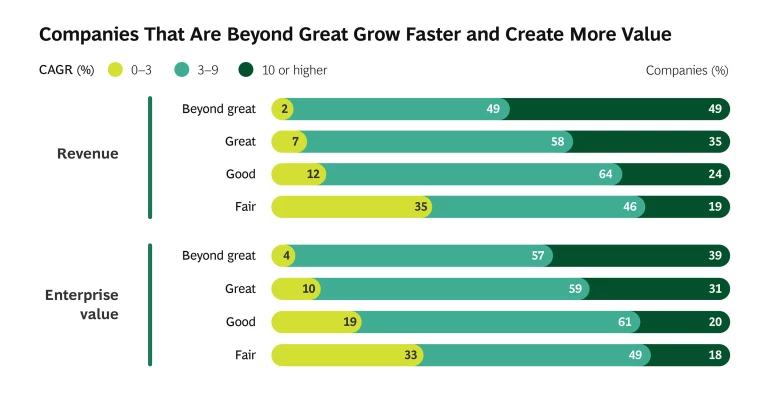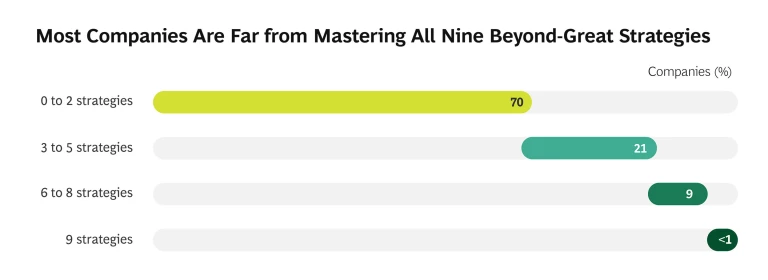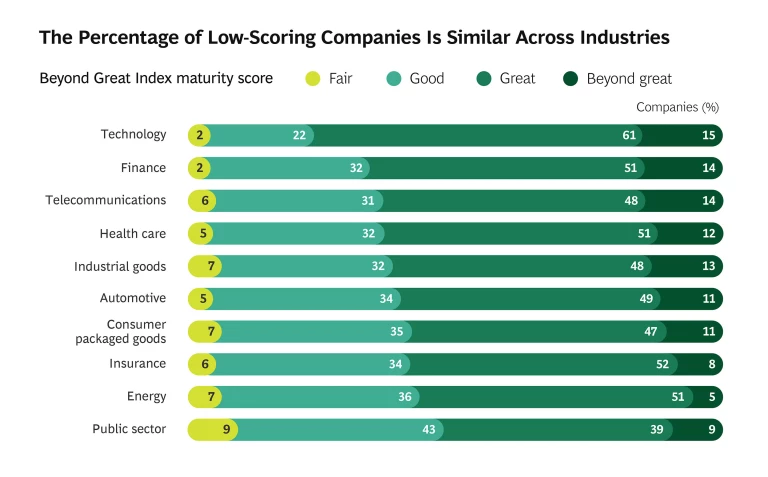Outstanding performance was once the hallmark of a great company. Year after year, it delivered exceptional total shareholder return through differentiated products or services while increasing scale and cost efficiency. No small feat.
But three powerful global forces—social tension, economic nationalism, and technological revolution—have changed the rules. Focusing on shareholder returns and delivering great performance are no longer good enough. It’s time for a new playbook—one that can take a great company to a new level.
Beyond Great is that playbook. It explores nine strategies that can help great companies up their game and contend with today’s complex forces. And a new tool, the Beyond Great Index, helps answer this critical question: Is the juice worth the squeeze?
The index tells us that going beyond great is hard no matter the industry; less than 1% of companies have mastered all nine strategies. But it also shows that a select number have forged ahead and are further along on the journey. These companies are realizing higher revenue growth, increasing shareholder value, and creating a positive impact for all stakeholders.
Building Sustainable Advantage in the New Global Reality
To be prepared for this new era and the next shocks, business leaders need to create their individualized path using a combination of nine key strategies that are organized around three themes. The company must then master the selected strategies.
To grow beyond great, leaders must:
- Do good, grow beyond. Reimagine core operations to create value for all stakeholders—customers, employees, and the community—as well as shareholders.
- Stream it, don’t ship it. Offer compelling digital solutions and experiences, not just physical products or services.
- Refine your global game. Grow selectively—rather than everywhere all at once—by choosing areas where the company can claim profitable market share, and grow in ways that are suitable for the local environment.
To operate beyond great, leaders need to:
- Engineer an ecosystem. Supplement traditional value chains with dynamic new value webs that can create and deliver the solutions, outcomes, and experiences that customers crave.
- Flex how you make it. Invest in high-tech local factories and delivery centers that, when combined with low-cost capacities, can quickly deliver customized offerings.
- Let the data run through it. Build a global data architecture and analytical capabilities to underpin the other eight strategies.
And to organize beyond great requires leaders to:
- Get focused, fast, and flat. Move away from the traditional organization model in favor of agile, customer-focused teams.
- Thrive with talent. Acquire, inspire, empower, and upskill a digitally savvy, engaged workforce.
- Embrace always-on transformation. Become adept at pursuing multiple transformations on an ongoing basis instead of traditional one-and-done change initiatives. This strategy is essential for succeeding with the other eight.
The Juice Is Worth the Squeeze
The Beyond Great Index is based on a BCG survey of leaders from approximately 2,400 companies representing all regions and industries. We took the data from that survey to create composite scores reflecting performance in each of the nine strategies—results that show companies’ progress on the beyond-great journey.
We found that companies with a high maturity score and the purposeful motivation to bring value to all stakeholders have accrued significant financial benefits. They are also growing faster than their peers.
In other words, the juice is worth the squeeze. A number of companies have already become adept at many of the nine strategies, but our research shows that most have a lot of work to do—with the majority having mastered two or fewer strategies.
The index reveals that the percentage of companies with low maturity scores is similar across industries.
Prepare and Pivot to Go Beyond Great
The first step on the journey to move beyond great is to understand the starting point. The Beyond Great Index will tell a company in which areas it leads and lags its peers. This will help provide the compelling case for change that will be crucial fuel for the journey ahead.
Once a company knows where it stands in its industry and how urgently it may need to make progress, it is critical for leaders to develop a shared point of view about the company’s direction and the combination of strategies to use.
This process requires a mix of art and science, data and judgment, and time and effort. It also depends on leaders having the courage to say no to allocating resources to strategies that are not critical to the success of this journey and to freeing up resources for those that are. For most companies, this means pivoting from the path that they’ve been on to a new one—a path that is customized using a new playbook. That pivot is at the heart of the shift to beyond great.
Lessons from Beyond-Great Exemplars
John Deere and Microsoft are two excellent examples of companies that have successfully made the shift. In both cases, their leaders knew that great performance was no longer good enough. Their willingness to prepare and pivot set them up for sustained future advantage by growing beyond great, operating beyond great, and organizing beyond great, and they have prospered even during the pandemic.
John Deere
Known for more than 180 years as a farming-equipment provider, John Deere may not have seemed poised to turn the ancient industry of agriculture on its head. But that’s just what it has done in recent years.
The impetus for change was an awareness among leaders that the company stood the risk of becoming a low-margin contract manufacturer, cut off from customers who needed solutions that went well beyond tractors. John Deere needed to pivot from iron to information.
That shift has meant integrating several of the nine strategies, starting with this one: stream it, don’t ship it. By gathering data from sensors built into its agricultural equipment—along with information about weather, soil conditions, crop features, and more—John Deere can now give farmers the opportunity to make informed decisions and unlock new sources of value.
The company forged a variety of partnerships so that it could offer customers complete solutions, including an agronomic weather analytics platform, along with soil sensors, drone technology, field mapping from yield monitors, and complex farm-management software. All of this has required John Deere to fully embrace another strategy: let the data run through it. And developing these new platforms has meant mastering this strategy: thrive with talent. The company has taken steps to hire, train, and borrow the workers needed to develop and deploy these solutions.
John Deere is now a preferred partner for farmers worldwide, laying the foundation for future growth. As the company increases its ability to deliver better economic outcomes for farmers, it is also applying the same processes and technology to new crop-production systems—fortifying its leadership in North America and other regions and driving higher profitability. In June of 2020, John Deere announced a new operating model to further unlock value for customers by accelerating smart technology innovation. Since the announcement, the company’s stock has risen by 100%.
Microsoft
Another company that has made big strides in its beyond-great journey is Microsoft. In 2014, when Satya Nadella became Microsoft’s CEO, the company was in solid shape, with healthy revenues, operating margins of 32%, and $85.7 billion in cash and short-term investments. Yet the company’s share price had stagnated, its market capitalization hovered around $346 billion, and its future prospects were unclear.
Although Microsoft’s legacy businesses were preforming well, the company had missed almost every major technology trend over the past decade, including mobile phones, search engines, and social networking. It now seemed poised to miss yet another massive trend—the cloud—as its competitors were far outpacing it in that area.
Under Nadella, a career Microsoft engineer, the company made a crucial pivot, moving from an internally focused and destructively competitive culture to one based on a growth mindset, an obsession with customers, a bias to collaborate, diversity and inclusion, and a conviction to make a positive impact on society. This involved following a unique pathway that emphasized several of the nine strategies, including: do good, grow beyond; engineer an ecosystem; let the data run through it; get focused, fast, and flat; and embrace always-on transformation. In addition to maintaining its focus on personal computers, Microsoft began developing cloud and mobile-related offerings. And then it evolved further, emphasizing AI over mobile.
Although this pivot began well before COVID-19, the pandemic dramatically accelerated it. “We’ve seen two years’ worth of digital transformation in two months,” said Nadella in his first quarterly earnings report during the pandemic. “From remote teamwork and learning, to sales and customer service, to critical cloud infrastructure and security—we are working alongside customers every day to help them adapt and stay open for business in a world of remote everything.”
The company’s evolution didn’t occur in a single dramatic rupture with the past. Rather, it comprised a number of transformations undertaken in parallel over several years. For Microsoft, the juice has indeed been worth the squeeze. For example, its conviction to have a positive social impact led to the development of AI for Accessibility, which is committed to empowering the more than 1 billion people around the world who live with a disability, focusing on accessibility within the home, community, school, and workplace. And the Microsoft Airband initiative has expanded internet access to 14 million people in rural areas around the world. The company’s market capitalization has increased dramatically under Nadella’s leadership, from $314 billion in 2014 to more than $2 trillion today.
Where is your organization on the journey to beyond great? Do you need to pivot away from the status quo?
Chances are that your company’s performance is good—maybe even great. But the Beyond Great Index tells us that you likely haven’t led your company beyond great and that there are others in your industry that are ahead of you on the journey.
As the John Deere and Microsoft examples show, there is no one-size-fits-all recipe for success. Instead of trying to excel in all strategies, you must prepare for the journey and be willing to pivot away from the path you’ve been on. The new pathway should be determined by having an understanding of the starting point, the case for change, the destination, and the road that will get you there.
To build sustainable advantage for the future amid the disruptive forces of social tension, economic nationalism, and technological revolution, time is of the essence. But the prize for going beyond great is huge—including the opportunity to deliver outstanding value to all stakeholders by an organization filled with people who are inspired and energized by the journey to beyond great.
Discover more about the rules for success in the
Beyond Great
book.













